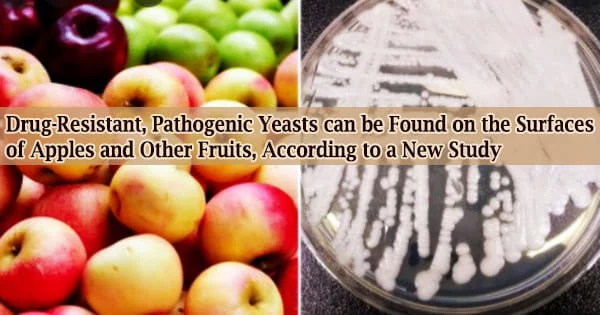Apples and other fruits are frequently sprayed with a fungicide before transit to prevent rotting and improve shelf life. The method preserves freshness, but it could be a double-edged sword: it could aid in the selection and spread of multi-drug resistance pathogenic yeasts.
Drug resistance occurs when a medicine, such as an antibiotic or antineoplastic, loses its effectiveness in treating a disease or condition. The phrase is actually used in the context of pathogen or cancer resistance that has “acquired,” that is, resistance that has evolved.
New evidence for that theory was published this week in mBio, an open-access publication of the American Society for Microbiology.
Previous research has looked at the effect of fungicides on the human pathogen Aspergillus fumigatus, but the new study focuses on drug-resistant strains of Candida auris, a pathogenic yeast that has been isolated from nature and spreads swiftly in hospitals.
“Fungicides used in agriculture may inadvertently select the drug resistant fungi,” Chowdhary said.
She and her colleagues looked for pathogenic C. auris and other yeasts on the surfaces of 84 fruits representing nine different tree fruit kinds. The fruits, which comprised 62 apples, were harvested in northern India in 2020 and 2021; 20 were plucked from orchards and 42 were acquired from a Delhi market. At least one form of yeast was found in each fruit species.
When we look at human pathogens, we tend to look at what’s immediate to us. But we have to look at it more broadly. Everything is connected, the whole system. Fruit is just 1 example.
Jianping Xu
Another group of opportunistic pathogens is Candida, which causes oral and vaginal infections in humans known as candidiasis. Candida is a commensal yeast that lives in humans and other warm-blooded animals’ mucous membranes.
The researchers concentrated on the apples. They discovered drug-resistant strains of C. auris on 8 apples (13%) and identified 16 different colonies using whole genome sequencing.
Five ‘Red Delicious’ and three ‘Royal Gala’ kinds were among the apples. None of the newly picked apples had C. auris because they had been stored before purchase.
Other Candida strains were discovered on the packaged apples, according to McMaster University microbiologist Jianping Xu, Ph.D. The study was co-led by Xu and Chowdhary.
Many medications are resistant to C. auris. It was initially discovered in Japan in 2009, and since then it has spread to every inhabited continent. Researchers have been looking into where the infection comes from and how it spreads.
“We still don’t really understand the forces that drive the simultaneous emergence of multiple distinct genetic clusters of C. auris,” Xu said.
The first time C. auris was isolated from a natural setting, the marshes and sandy beaches of a natural coastal ecosystem in the Andaman Islands, India, was published in mBio last year.
According to the latest research, apples may act as a selecting force for the disease, aiding its spread. Despite the fact that the study focused on fruits collected in northern India, Xu pointed out that the spread of C. auris is not unique to India.
C. auris is a global hazard: The Centers for Disease Control and Prevention named C. auris as one of five diseases that represent an immediate threat to public health around the world in 2019. Researchers need to know how the disease moves through other natural systems in order to find out how to respond to its threat to humans.
“When we look at human pathogens, we tend to look at what’s immediate to us,” Xu said. “But we have to look at it more broadly. Everything is connected, the whole system. Fruit is just 1 example.”
Fungi are an important element of the environment, and according to Chowdhary, the new study demonstrates how the environment, animals, and humans are all connected, which is a core tenet of the One Health idea.
“The One Health concept warrants continuous efforts and our attention in preventing the transmission of infections,” she said.
















